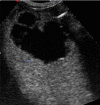Acute nontraumatic liver lesions
- PMID: 24432172
- PMCID: PMC3846952
- DOI: 10.1007/s40477-013-0049-2
Acute nontraumatic liver lesions
Abstract
The principal conditions requiring emergency/urgent intervention in patients with nontraumatic liver lesions are hemorrhage (with or without tumor rupture), rupture of hydatid cysts (with or without infection), complications arising from liver abscesses or congenital liver cysts, rupture related to peliosis hepatis, and in rare cases spontaneous hemorrhage. This article examines each of these conditions, its appearance on ultrasound (the first-line imaging method of choice for assessing any urgent nontraumatic liver lesion) and indications for additional imaging studies.
Le principali cause di emergenza/urgenza in patologia epatica non traumatica sono l’emorragia con o senza rottura di neoplasie epatiche, la rottura con o senza infezione delle cisti idatidee, le complicanze degli ascessi epatici, delle cisti congenite del fegato, l’emorragia, la rottura in corso di peliosi epatica e la rara emorragia spontanea. Dopo aver esaminato singolarmente le varie cause di emergenza/urgenza, i rispettivi aspetti ecografici e l’integrazione con altre metodiche di imaging si conclude che nei pazienti con patologia epatica l’ecografia, con o senza mezzo di contrasto, è la metodica da utilizzare in prima istanza ad ogni emergenza/urgenza non traumatica del fegato.
Keywords: Acute liver disorders; Contrast-enhanced ultrasound; Ultrasound.
Figures








References
-
- Vivarelli M, Cavallari A, Bellusci R, De Raffele E, Nardo B, Gozzetti G. Ruptured hepatocellular carcinoma:an important cause of haemoperitoneum. Eur Surg. 1995;161(2):881–886. - PubMed
Publication types
LinkOut - more resources
Full Text Sources
Other Literature Sources

